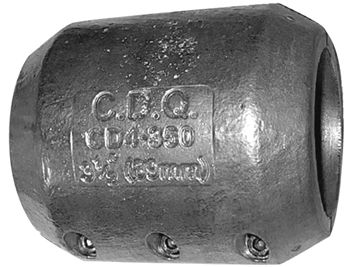- Home /
- General Equipment /
- Marine Engineering /
- Zinc Anodes /
- Hull Anodes /
- Shaft & Rudder Anodes /
- Sacrificial Zinc Shaft Anodes - Heavy Duty
Shop Now
- Anchoring & Mooring
- Boat Maintenance
- Deck Hardware
- Electrical
- Fishing Equipment
-
General Equipment
- Cabin Hardware
- Coverings
- Galley
- Handles, Handrails & Fittings
- Hatch Hardware
- Marine Engineering
- Navigation
- Seat & Table Assemblies
- Ski Accessories
- Trailer Components
- Tube Clips
- Ventilators
- Windscreen Wipers & Accessories
- Marine Clothing
- Marine Electronics
-
Plumbing
- Fresh Water Systems
- Hose & Hose Accessories
- Pumps
- Toilet Systems
- Rigging Products
- Safety Equipment
-
Sailing Hardware
-
Blocks
- Harken
-
Ronstan
- Deck Organisers
- Lightweight Blocks
- Orbit Series Block Accessories
- Ronstan General Purpose Blocks
- Ronstan Wire Rope Blocks
- Series 100 Core Blocks
- Series 15 Ball Bearing
- Series 20 Ball Bearing
- Series 30 Orbit Blocks
- Series 40 All Purpose Blocks
- Series 40 Orbit BB Blocks
- Series 40 Orbit Blocks
- Series 40 Orbit Ratchet Blocks
- Series 50 All Purpose Blocks
- Series 55 Orbit Blocks
- Series 55 Orbit Ratchet Block
- Series 60 Core Blocks
- Series 70 Orbit Blocks
- Series 75 Core Blocks
- Sheave Boxes/Exit Blocks
- Snatch Blocks
- Utility Blocks
- Stainless Steel Hardware Blocks
- Boom Fittings
- Mast Tangs & Hounds
- Rope Stoppers
- Rudder & Tiller Fittings
- Saddles, Fairleads & Bushes
- Sail Furlers and Feeders
- Sail Slides, Hanks & Shackles
- Sheet Winches & Access.
- Shock Cord Ends & Tiedowns
- Spinnaker Pole Ends & Fittings
- Spreader/Mast Fittings
- Stay Adjusters
- Tiller Extensions and Uni Joints
- Trapeze Hardware
- Traveller Tracks
- Wind Direction Indicators
-
Blocks
- Sta-Lok Swageless Rigging Components

Sacrificial Zinc Shaft Anodes - Heavy Duty
Description
Whenever you have two or more dissimilar metals in contact, or in close proximity to each other, in combination of an electrolyte i.e salt water, a small electric current will flow from the most noble metal(cathodic) to the least noble metal(anodic). When this occurs, the least noble metal will be attacked and gradually destroyed in what is commonly called "galvanic corrosion". The intensity of this attack will vary according to the relative position of metals on the Galvanic Series List. The further apart the metals are, the faster it occurs and the worst the effects are. The relative areas or the mass of the metals also has a bearing. To overcome this it is common practise (and prudent!) to electrically connect all underwater metals components that are in contact or close proximity to each other to a zinc alloy block. Because zinc is one of the least noble or anodic metals, it will be eaten away first, rather than those other inexpensive and unneccessary metal objects under the water, such as your propellor, rudder, shaft etc !! Hence the term "Sacrificial anode.
All our zinc anodes conform to the zinc alloy composition designated in Australian Standard 2239-Z1, as well as U.S. Naval Mil.Spec. MIL-A-18001, recognised as the world standard for anode quality.
These heavy-duty anodes come in two halves and are placed around the propellor shaft or rudder post, held in place by the tension you apply to the fasteners as you clamp it back together again.

